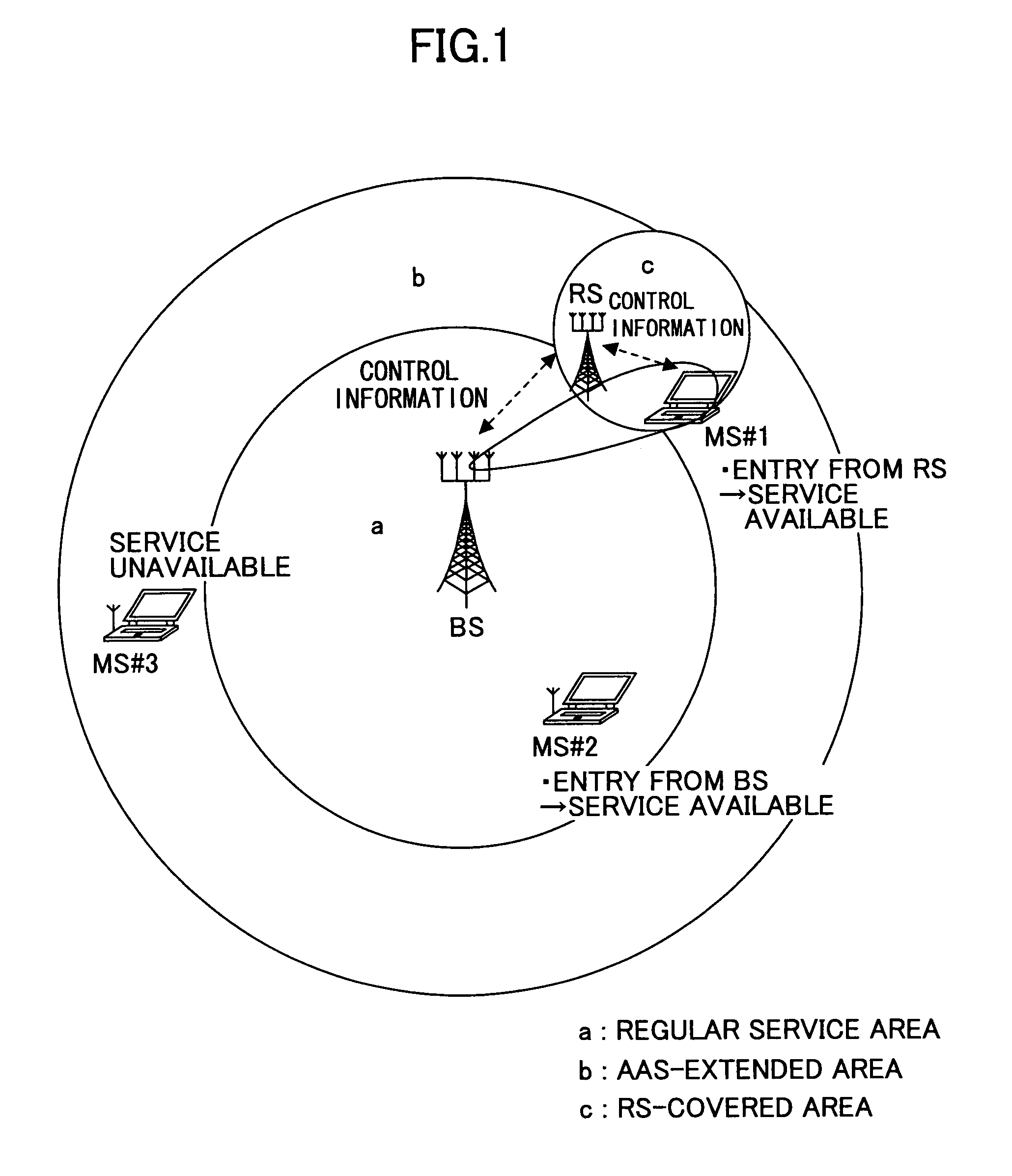Radio communications system and antenna pattern switching
a radio communication system and antenna pattern technology, applied in the field of radio communications systems and radio communications control methods, can solve the problems of not being able to receive communications services, terminals outside the service area of omnidirectional antennas cannot form beams in the direction of terminals, and taking a long time before network entry, so as to reduce the number of hops and achieve efficient radio communications services
- Summary
- Abstract
- Description
- Claims
- Application Information
AI Technical Summary
Benefits of technology
Problems solved by technology
Method used
Image
Examples
first embodiment
[0027]FIG. 1 is a diagram showing the relationship between the disposition of a radio base station (hereinafter also abbreviated as “BS”), terminals or mobile stations (hereinafter also abbreviated as “MS#1, MS#2, and MS#3), and a radio relay station (hereinafter also abbreviated as “RS”) and service areas according to a first embodiment of the present invention. As examples of service areas, FIG. 1 shows a regular service area a, which is a service area in the case where the BS performs no beamforming or forms no beam; an AAS-extended area b, which is an extended service area in the case where beamforming by an adaptive array system (AAS) or a system according to a directional antenna gain pattern is performed; and an RS-covered area c, which is a service area covered by the RS. Further, as examples of terminals, FIG. 1 shows the MS#1 in the regular service area a, the MS#2 in the AAS-extended area b, and the MS#3 in the RS-covered area c.
[0028]Referring to FIG. 1, a radio communic...
second embodiment
[0039]FIG. 5 is a diagram for illustrating a second embodiment of the present invention. The regular service area a covered by the omnidirectional antenna gain pattern of the BS, the AAS-extended area b, which is an area extended based on the directional adaptive array antenna gain pattern, and the RS-covered area c, which is the service area of the RS, are the same as in the case shown in FIG. 1. Further, the BS, the RS, and the terminal (MS#1) have the same configurations as those shown in FIG. 2. When the BS recognizes (or determines) from response information from the MS#1 through the RS that the MS#1 is positioned in the RS-covered area c, the BS performs control to direct a beam toward the RS. It is requested that the direction of the beam be optimized. For this purpose, the BS causes the beam to scan so as to cover the entire RS-covered area c. The BS is notified of the resulting reception conditions, for example, the measurement results by SINR measurement means, of the MS#1...
third embodiment
[0043]FIG. 7 is a diagram for illustrating a third embodiment of the present invention. The regular service area a covered by the omnidirectional antenna gain pattern of the BS, the AAS-extended area b, which is an area extended based on the directional adaptive array antenna gain pattern, and the RS-covered area c, which is the service area of the RS, are the same as in the case shown in FIG. 1. Further, the BS, the RS, and the terminal (MS#1) have the same configurations as those shown in FIG. 2. When the MS#1 in the RS-covered area c moves to the AAS-extended area b outside the RS-covered area c when the MS#1 is performing communications according to the communication form of Method 3 (BS / RS / MS) of FIG. 6, that is, performing transmission and reception of control information and user data through the RS as indicated by broken arrows as control / data, it is necessary to switch the communication form to Method 1 (BS / MS [beam forming]). In this case, monitoring reception quality in t...
PUM
 Login to View More
Login to View More Abstract
Description
Claims
Application Information
 Login to View More
Login to View More - R&D
- Intellectual Property
- Life Sciences
- Materials
- Tech Scout
- Unparalleled Data Quality
- Higher Quality Content
- 60% Fewer Hallucinations
Browse by: Latest US Patents, China's latest patents, Technical Efficacy Thesaurus, Application Domain, Technology Topic, Popular Technical Reports.
© 2025 PatSnap. All rights reserved.Legal|Privacy policy|Modern Slavery Act Transparency Statement|Sitemap|About US| Contact US: help@patsnap.com



